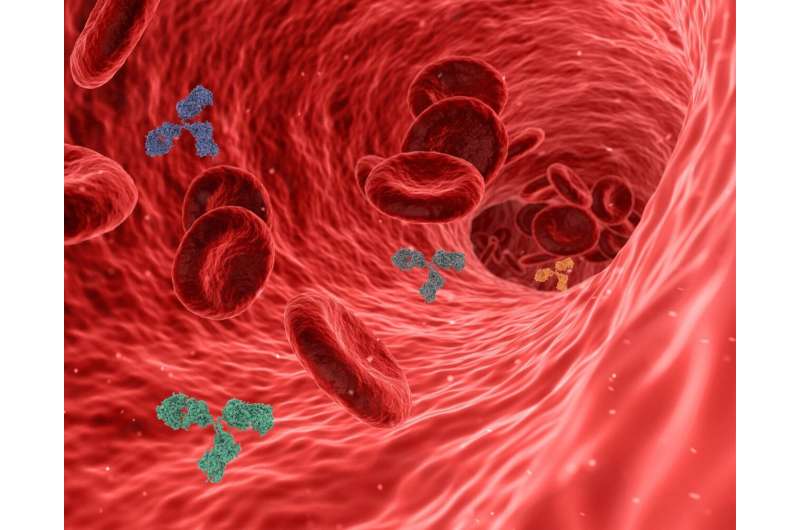This article has been reviewed according to Science X's editorial process and policies. Editors have highlighted the following attributes while ensuring the content's credibility:
fact-checked
peer-reviewed publication
trusted source
proofread
3D-printed blood vessels bring artificial organs closer to reality

Growing functional human organs outside the body is a long-sought "holy grail" of organ transplantation medicine that remains elusive. New research from Harvard's Wyss Institute for Biologically Inspired Engineering and John A. Paulson School of Engineering and Applied Science (SEAS) brings that quest one big step closer to completion.
A team of scientists has created a new method to 3D-print vascular networks that consist of interconnected blood vessels possessing a distinct "shell" of smooth muscle cells and endothelial cells surrounding a hollow "core" through which fluid can flow, embedded inside a human cardiac tissue. This vascular architecture closely mimics that of naturally occurring blood vessels and represents significant progress toward being able to manufacture implantable human organs.
The achievement is published in Advanced Materials.
"In prior work, we developed a new 3D bioprinting method, known as 'sacrificial writing in functional tissue' (SWIFT), for patterning hollow channels within a living cellular matrix. Here, building on this method, we introduce coaxial SWIFT (co-SWIFT) that recapitulates the multilayer architecture found in native blood vessels, making it easier to form an interconnected endothelium and more robust to withstand the internal pressure of blood flow," said first author Paul Stankey, a graduate student at SEAS in the lab of co-senior author and Wyss Core Faculty member Jennifer Lewis, Sc.D.
The key innovation developed by the team was a unique core-shell nozzle with two independently controllable fluid channels for the "inks" that make up the printed vessels: a collagen-based shell ink and a gelatin-based core ink. The interior core chamber of the nozzle extends slightly beyond the shell chamber so that the nozzle can fully puncture a previously printed vessel to create interconnected branching networks for sufficient oxygenation of human tissues and organs via perfusion. The size of the vessels can be varied during printing by changing either the printing speed or the ink flow rates.
To confirm the new co-SWIFT method worked, the team first printed their multilayer vessels into a transparent granular hydrogel matrix. Next, they printed vessels into a recently created matrix called uPOROS, composed of a porous collagen-based material that replicates the dense, fibrous structure of living muscle tissue. They were able to successfully print branching vascular networks in both of these cell-free matrices. After these biomimetic vessels were printed, the matrix was heated, which caused collagen in the matrix and shell ink to crosslink, and the sacrificial gelatin core ink to melt, enabling its easy removal and resulting in an open, perfusable vasculature.
Moving into even more biologically relevant materials, the team repeated the printing process using a shell ink that was infused with smooth muscle cells (SMCs), which comprise the outer layer of human blood vessels. After melting out the gelatin core ink, they then perfused endothelial cells (ECs), which form the inner layer of human blood vessels, into their vasculature. After seven days of perfusion, both the SMCs and the ECs were alive and functioning as vessel walls—there was a three-fold decrease in the permeability of the vessels compared to those without ECs.
Finally, they were ready to test their method inside living human tissue. They constructed hundreds of thousands of cardiac organ building blocks (OBBs)—tiny spheres of beating human heart cells, which are compressed into a dense cellular matrix. Next, using co-SWIFT, they printed a biomimetic vessel network onto the cardiac tissue. Finally, they removed the sacrificial core ink and seeded the inner surface of their SMC-laden vessels with ECs via perfusion and evaluated their performance.
Not only did these printed biomimetic vessels display the characteristic double-layer structure of human blood vessels, but after five days of perfusion with a blood-mimicking fluid, the cardiac OBBs started to beat synchronously—indicative of healthy and functional heart tissue. The tissues also responded to common cardiac drugs—isoproterenol caused them to beat faster, and blebbistatin stopped them from beating. The team even 3D-printed a model of the branching vasculature of a real patient's left coronary artery into OBBs, demonstrating its potential for personalized medicine.
"We were able to successfully 3D-print a model of the vasculature of the left coronary artery based on data from a real patient, which demonstrates the potential utility of co-SWIFT for creating patient-specific, vascularized human organs," said Lewis, who is also the Hansjörg Wyss Professor of Biologically Inspired Engineering at SEAS.
In future work, Lewis's team plans to generate self-assembled networks of capillaries and integrate them with their 3D-printed blood vessel networks to more fully replicate the structure of human blood vessels on the microscale and enhance the function of lab-grown tissues.
"To say that engineering functional living human tissues in the lab is difficult is an understatement. I'm proud of the determination and creativity this team showed in proving that they could indeed build better blood vessels within living, beating human cardiac tissues. I look forward to their continued success in their quest to one day implant lab-grown tissue into patients," said Wyss Founding Director Donald Ingber, M.D., Ph.D. Ingber is also the Judah Folkman Professor of Vascular Biology at HMS and Boston Children's Hospital and Hansjörg Wyss Professor of Biologically Inspired Engineering at SEAS.
Additional authors of the paper include Katharina Kroll, Alexander Ainscough, Daniel Reynolds, Alexander Elamine, Ben Fichtenkort, and Sebastien Uzel.
More information: Paul P. Stankey et al, Embedding Biomimetic Vascular Networks via Coaxial Sacrificial Writing into Functional Tissue, Advanced Materials (2024). DOI: 10.1002/adma.202401528
Journal information: Advanced Materials
Provided by Harvard University




















